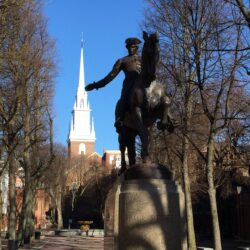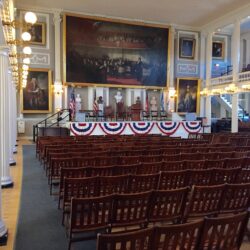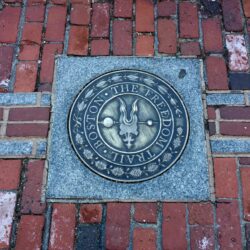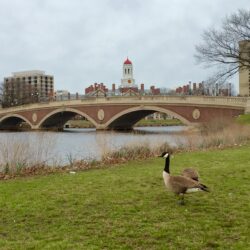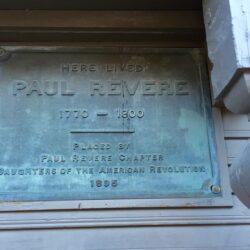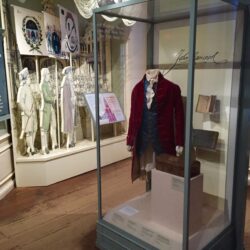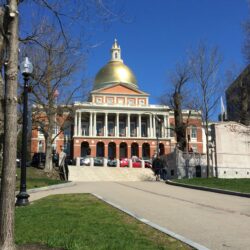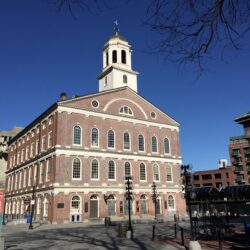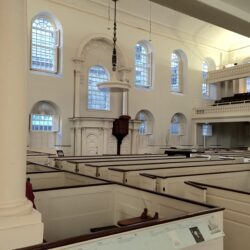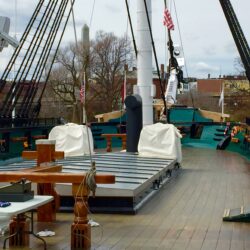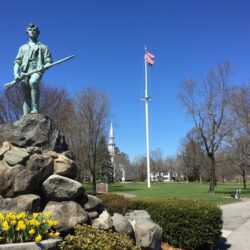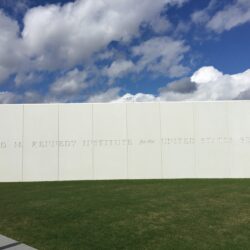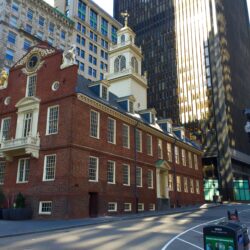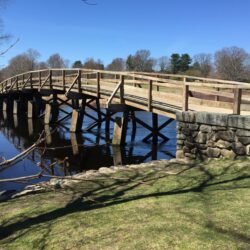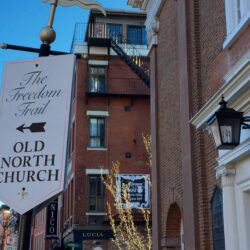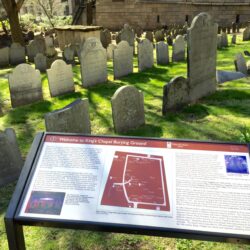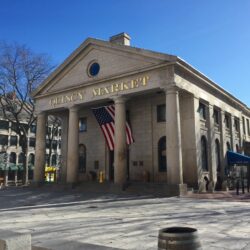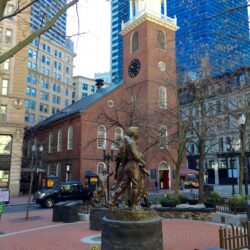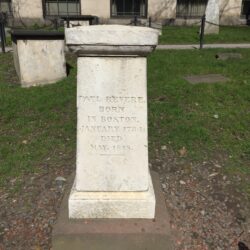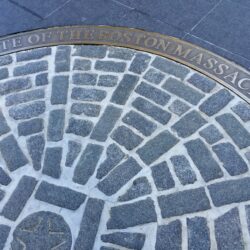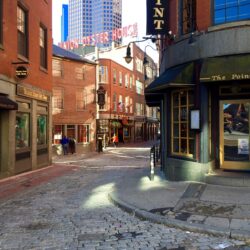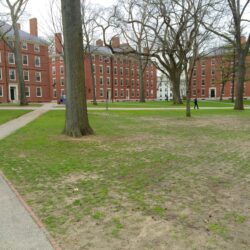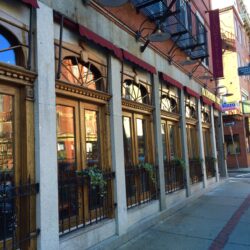A screenwriting class that gives sightseeing advice for Boston too? Yes!
.
Some selected Boston Tourism Suggestions and Tips
Birthplace and Cradle of the American Revolution, The Nation, and Freedom – Boston or Philadelphia?
Boston and Philadelphia are definitely locked in a competition for top billing as a place to see significant historical sites related to American independence and democracy. It’s a close call, and tourism publications from both places use the same Revolutionary-principles phraseology to describe their history and historical tourism gems. The real truth is that, to visit the most important sites to America’s birth, you’d need to see both cities.
In the road-to-independence category of historical sites, Boston offers a number of key attractions:
Faneuil Hall – 18th Century site of speeches advocating independence from England by Samuel Adams and other early American patriots. The hall was greatly expanded soon after the turn of the 19th Century by the same architect who designed the first (bell-shaped) U.S. Capitol dome and the current Massachusetts State House. The meeting hall of Faneuil Hall is ornate and impressive. The Hall is part of Boston’s famed Freedom Trail, an actual brick (and sometimes red paint) marked trail that winds its way across the sidewalks and streets of the North End and downtown Boston. The Faneuil Hall Marketplace and Quincy Marketplace shops and restaurants just east of Faneuil Hall are favorites for Boston visitors.
Old State House – The building that stands today is the old state house that was built in 1713, and it has to be one of the most unique buildings that’s ever served as a state capitol. A little more than a block away from Faneuil Hall, this building is today surrounded by 20th Century office towers. Just outside its east entrance, on March 5, 1770, the Boston Massacre occurred. A marker memorializes the spot of the massacre, and the sites are part of the Freedom Trial.
Old South Meeting House – Built in 1729 and once the largest building in Boston, this hall was the organizing location for the Boston Tea Party. It’s meeting room is large and interesting, although it’s much plainer than the meeting room of Faneuil Hall. The building is also part of the Freedom Trail.
Old Granary Burial Ground – Half a block from the northeast end of Boston Common and right next to Suffolk University Law School, this three and half centuries-old cemetery is the resting place of the owner of the most grandiose signature in American history, John Hancock, and two other signers of the Declaration of Independence, Samuel Adams and Robert Treat Paine. Here also rests Paul Revere and Crispus Attucks, an African-American victim of the Boston Massacre (in a grave with four other Massacre victims). On the Freedom Trail.
King’s Chapel Burying Ground – Across Beacon Street and half a block from Old Granary and just a tad older than Old Granary. Site of the Winslow tomb, believed to be the final resting place of Mary Chilton Winslow, a Mayflower passenger and the first European woman to set foot in New England (at age 12 when she was just Mary Chilton).
The Old North Church and the North End – The famous lantern-signal steeple was actually destroyed twice by fierce storms, once in 1804 and then again in the 1950s. The reconstructed steeple marks the place where signals were sent to Charlestown-situated riders ready to assist Paul Revere and John Dawes with warnings of British troop advancements to towns west of Boston. The Italian cuisine is exceptional in the historic Freedom Trail neighborhood, where a number of other noteworthy restaurants reside.
Paul Revere House – Also in the North End, this house, built in 1680, is the oldest building in downtown Boston. Revere, a silversmith, departed the house on the night of April 18, 1775 to first cross the mouth of the Charles River by rowboat and then ride by horse to Lexington (and a little beyond) telling (not shouting) nearly every house along the way that “the Regulars are coming out.” In Lexington, Revere discussed what to do next with Samuel Adams and John Hancock. Dr. Samuel Prescott joined Revere from there. Prescott made it to Concord; Revere was captured and did not.
U.S.S. Constitution – The world’s oldest commissioned naval vessel still afloat, named by George Washington himself (later nicknamed “Old Ironsides” by Oliver Wendell Holmes) and launched in 1797, this triple-masted frigate fought the Barbary states in Tripoli harbor, fought the British in the War of 1812, served as a diplomatic vessel in the first half the 19th Century, served as a training vessel at the Naval Academy in Annapolis, delivered industrial exhibits to the Paris Exhibition of 1878, served as a (barely) floating platform for a military barracks, navigated the Panama canal in the 1930s, served as an officers’ brig, was reconstructed, and now serves as an educational and ceremonial fleet component of the U.S. Navy. As a floating, working ship, the Constitution must undergo intermittent restorations, but a visit to the ship at the Charlestown Navy Yard (with her in the water or in a special dry dock) is well worth it. In the snug gun deck, it’s easy to imagine the considerable noise and smoke that plagued the ears and lungs of the ship’s former cannon gunners. A museum dedicated to the ship sits next to its special dry dock, and the entire docks area (Charlestown Navy Yard) is part of the Boston National Historical Park. The docks are a fairly short walk away from the Bunker Hill monument.
Bunker Hill monument – Finished five years before the construction on the much taller Washington Monument began, this obelisk commemorates the Battle of Bunker Hill, the first major conflict between British and American troops in the Revolutionary War, which happened on the site in 1775. You can climb its 294 steps to the top for a great view of Boston harbor and all of Boston.
Boston Tea Party Museum – You can reenact the throwing overboard of tea chests at this Congress Street Bridge private museum.
Clough House and the printing Offices of Edes & Gill – Built in 1712 in the North End at what is now 21 Unity Street, this historic house now houses Boston’s only colonial printing experience, run by a non-profit organization.
Longfellow House – This National Park Service site in Cambridge was used by General George Washington as his headquarters during the siege of Boston in 1775 and 1776. The poet Henry Wadsworth Longfellow later lived and wrote in the house for four decades. Longfellow’s family established a trust to preserve the house before it was taken over by the Park Service as a museum (about both Longfellow and Washington) in the early 20th Century.
The Lexington (Battle) Green and the Old North Bridge reconstruction/site at Concord – While they’re not in Boston and there’s not a lot at Lexington (although the Battle Green is pretty), they are critical the touching off points of the American Revolution and good photo spots. The approach to (and retreat path from) Concord is a national park, the Minute Man National Historical Park. This is a five-mile restored “battle trail” that approximates the path and tells the story of the skirmishes between British troops and colonial militiamen after the Revolutionary War was touched off. The park also includes the site where Paul Revere was captured during his famous ride. The Old North Bridge is a reproduction of the bridge where the “shot heard ’round the world” was fired. The location is authentic, though, and the grave of two of the three British soldiers who died in the famous first non-skirmish battle of the Revolutionary War sits at the eastern end of the bridge.
Other notable Boston attractions include the:
- Boston Common park and next-door Boston Public Garden (eat your heart out, Central Park; no trip to Boston is complete without a stroll through both; the current Massachusetts state house sits at the Common’s northeastern corner)
- Cheers bar exterior (on the north end of the Public Garden)
- Copley Square and Trinity Church (upscale shopping nearby; the church founded Richardson Romanesque design)
- Newbury Street (brownstone shops and restaurants)
- Columbus and South End picturesque neighborhoods
- New England Aquarium
- JFK Presidential Library and Museum (on the campus of UMass – Boston right next to the newer Edward M. Kennedy Institute for the U.S. Senate, which contains a full-scale replica of the U.S. Senate chamber)
- Harvard Square commercial area (restaurants, hotels, shops – not really situated around a true square) and Harvard Yard (open to the public even though visitors must enter through one of many gates or passageways in the fence- and structure-enclosed central grounds)
- And last in this list, but certainly not least, the Museum of Fine Arts, which contains many treasures, including Gilbert Stuart’s unfinished/Athenaeum portrait of George Washington, the mirror-image likeness of which appears on the dollar bill

